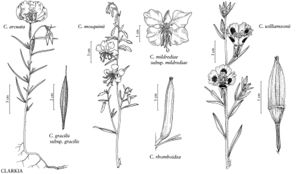familyOnagraceae
subfamilyOnagraceae subfam. Onagroideae
genusClarkia
sectionClarkia sect. Myxocarpa
speciesClarkia mildrediae
subspeciesClarkia mildrediae subsp. mildrediae
Difference between revisions of "Clarkia mildrediae subsp. mildrediae"
Treatment appears in FNA Volume 10.
imported>Volume Importer |
imported>Volume Importer |
||
| Line 42: | Line 42: | ||
|publication year= | |publication year= | ||
|special status= | |special status= | ||
| − | |source xml=https://xjsachs2@bitbucket.org/aafc-mbb/fna-data-curation.git/src/ | + | |source xml=https://xjsachs2@bitbucket.org/aafc-mbb/fna-data-curation.git/src/e39f0e846f172941159b2045254d62d10d9823f6/coarse_grained_fna_xml/V10/V10_375.xml |
|subfamily=Onagraceae subfam. Onagroideae | |subfamily=Onagraceae subfam. Onagroideae | ||
|tribe=Onagraceae tribe Onagreae | |tribe=Onagraceae tribe Onagreae | ||
Latest revision as of 10:32, 9 May 2022
Flowers: petals 12–18 mm wide; anthers magenta, fresh pollen blue-gray. 2n = 14.
Phenology: Flowering Jun–Jul.
Habitat: Yellow-pine forests.
Elevation: 400–1700 m.
Discussion
Subspecies mildrediae is known only from the Feather River drainage in the foothills of the southern Cascade–northern Sierra Nevada ranges in Butte, Plumas, Yuba, and barely Sierra counties, but is relatively abundant within that area. Nevertheless, it is listed as rare by the California Native Plant Society.
Selected References
None.
Lower Taxa
None.
